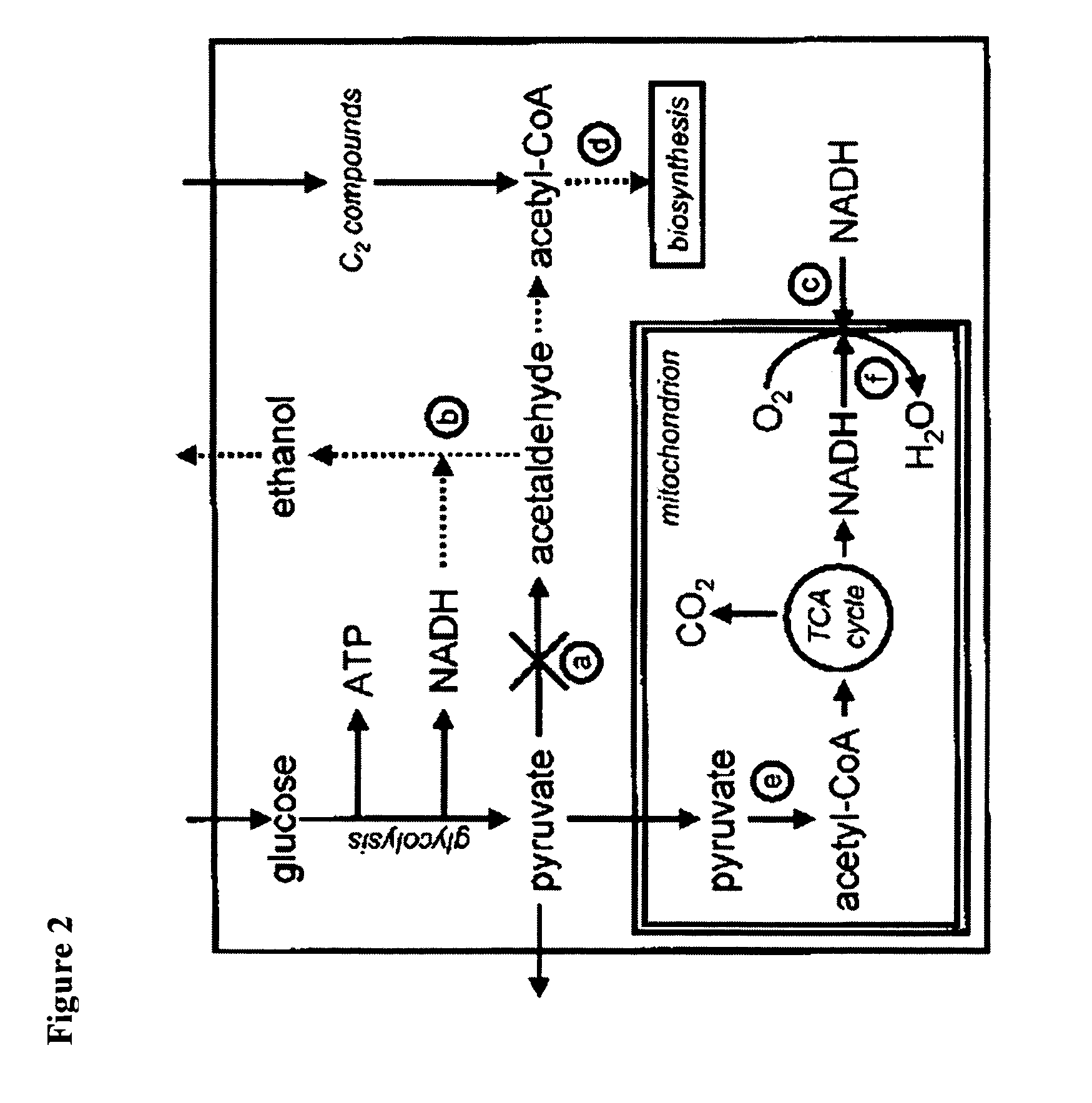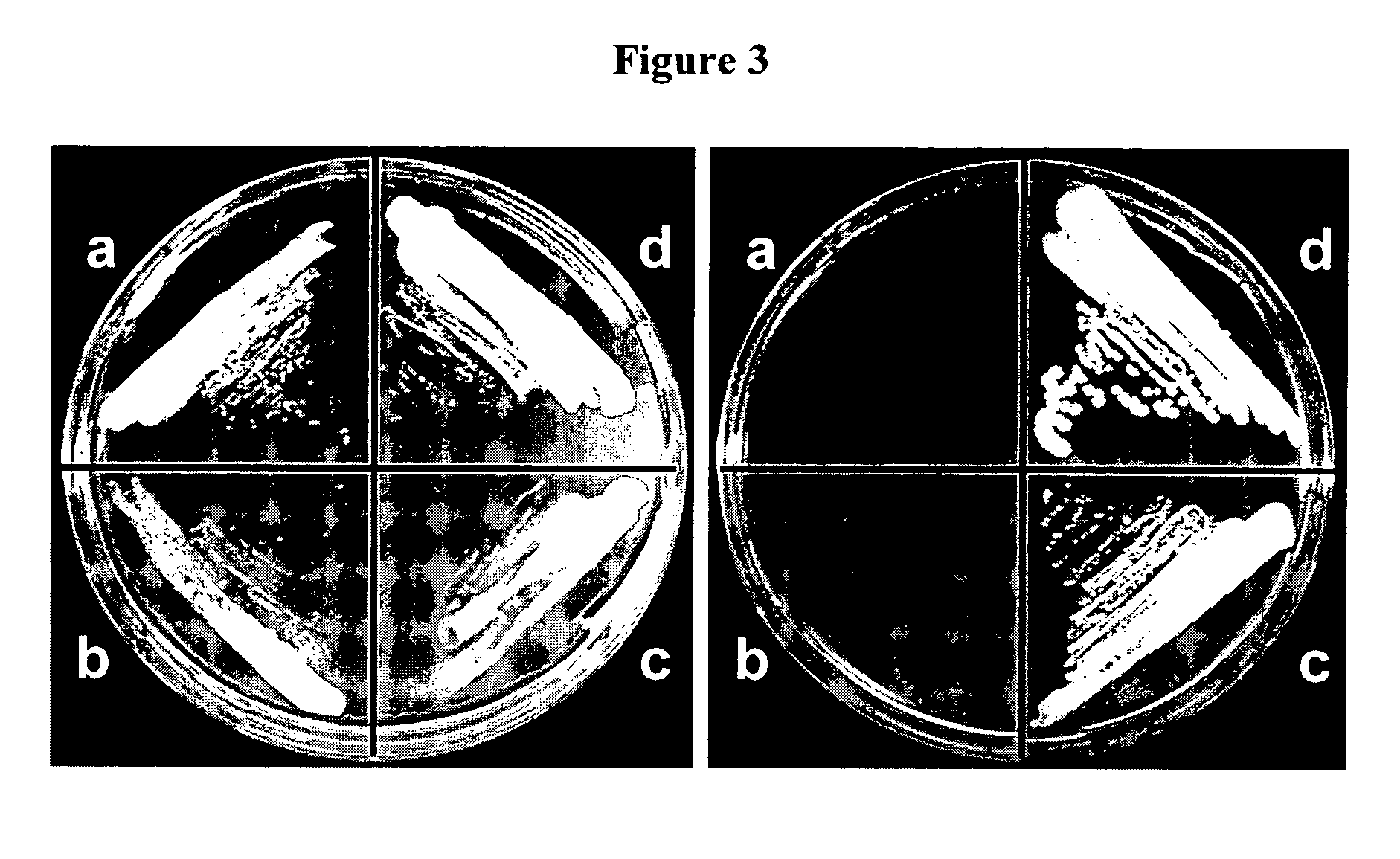Pyruvate producing yeast strain
a technology of pyruvate and yeast, which is applied in the field of yeast, can solve the problems of impaired growth at high sugar concentrations, lack of pyruvate decarboxylase activity, etc., and achieve the effect of increasing the level of threonine aldolase activity
- Summary
- Abstract
- Description
- Claims
- Application Information
AI Technical Summary
Benefits of technology
Problems solved by technology
Method used
Image
Examples
example 1
[0099]Two rounds of natural selection were used to obtain a Saccharomyces cerevisiae that has no detectable amount of pyruvate decarboxylase activity, that is C2 carbon source-independent and that is glucose tolerant from a Pdc negative Saccharomyces cerevisiae. The nature of the Pdc negative strain can be better understood by referring to FIG. 2.
[0100]By the deletion of all genes encoding for pyruvate decarboxylase (reaction a) in Saccharomyces cerevisiae, two important processes (dotted lines) are impaired. First reoxidation of cytosolic NADH via alcohol dehydrogenase (reaction b) is blocked. Cytosolic NADH must therefore be oxidized by the mitochondria via external NADH dehydrogenase (reaction c) or via redox shuttle systems. Secondly the formation of cytosolic acetyl-CoA from acetaldehyde is blocked. Instead, the C2 carbon source compounds required for the cytosolic acetyl-CoA for lysine and fatty-acid biosynthesis (reaction d) must be taken up from the environment. As oxygen co...
example 2
[0144]This example concerns the production characteristics of TAM strain transformed with YEpLpLDH. By using this strain as a host for the overexpression of a LDH gene the glycolytic flux can be at least partially redirected to lactate production.
[0145]The experiment involved two batch cultivations on mineral media with an oxygen limitation at 30° C. and pH 5.0 (titration with KOH 10 M).
[0146]Plasmid Construction
[0147]Amplification of the LDH Gene from L. plantarum Genomic DNA:
[0148]Genomic DNA was extracted from L. plantarum and a PCR was performed in order to amplify the LDH gene. The sequence for the LDH gene that was sequenced as part of the plasmid construct is listed as SEQ ID NO:3 below. The coding sequence amino acid sequence is listed as SEQ ID NO:4 below.
Oligos:
[0149]
LDH fwSEQ ID NO:15′ TGA CTT ATT ATG TCA AGC AT 3′LDH revSEQ ID NO:25′ ATC GTA TGA AAT GAT TAT TTA TT 3′PCR conditions:95° C. 3′95° C. 1′ {close oversize brace} × 33 cycles48° C. 1′72° C. 2′72° C.10′ 4° C.∞SEQ ...
example 3
[0192]This example concerns the production characteristics of TAM strain transformed with YEpLpLDH. The experiment involved batch cultivations on mineral media at 32° C. and without pH control.
[0193]Strains
[0194]The strain used was TAM with the yeast plasmid pLpLDH. The TAM host strain is as described above. YEpLpLDH comprises an LDH gene from a Lactobacillus plantarum strain functionally linked to a tpi promoter, and is described above.
[0195]The strains were grown at 32° C. in shake flasks on a mineral medium with glucose. The fermentation was carried out in 250 ml triple baffled shake flasks containing 100 ml medium. The medium composition is tabulated below.
Media
[0196]Glucose 75 g / L, trace elements, vitamins and salts listed below.
[0197]
TABLE 7The trace elements consisted of:Formulaμgl−1ZnSO4•7H2O712CuSO4•5H2O62.5Na2MoO4•2H2O235H3BO3500MnSO4•H2O450FeCl3200KI100
[0198]
TABLE 8The vitamins consisted of:Chemicalsμgl−1Biotin (D−)2Ca D(+) pantothenate400Inositol2000Folic acid2Thiamine h...
PUM
 Login to View More
Login to View More Abstract
Description
Claims
Application Information
 Login to View More
Login to View More - R&D
- Intellectual Property
- Life Sciences
- Materials
- Tech Scout
- Unparalleled Data Quality
- Higher Quality Content
- 60% Fewer Hallucinations
Browse by: Latest US Patents, China's latest patents, Technical Efficacy Thesaurus, Application Domain, Technology Topic, Popular Technical Reports.
© 2025 PatSnap. All rights reserved.Legal|Privacy policy|Modern Slavery Act Transparency Statement|Sitemap|About US| Contact US: help@patsnap.com



